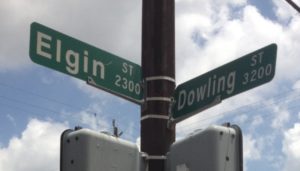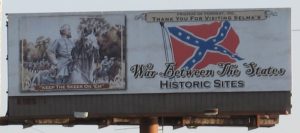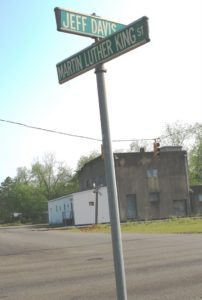This presentation was given during a panel discussion, “White Supremacy, Monuments, and Memory,” held at the University of Arizona on August 30. Dr. Katie Hemphill discussed the construction of Confederate monuments in the South from 1890-1920, and Dr. Susan Crane discussed the role of monuments in society.
I was born and raised in Texas, a state that has the second-largest number of Confederate monuments in the United States. Until recently, 178 Confederate monuments could be found in Texas, second only to the Virginia’s 223. Reminders of the Confederate past have been part of my life since birth – literally. I was born in Houston’s Jefferson Davis Hospital, named for the president of the Confederacy. As a teenager, I went to prom at Robert E. Lee High School. Growing up in Houston, the sight of buildings, streets and monuments named for Confederates was as common as live oak trees and petrochemical plants.
The ghosts of the Confederacy have haunted Houston’s black neighborhoods. For over 150 years, Dowling Street was the main thoroughfare of the city’s Third Ward. Dowling Street was home to Emancipation Park, the first piece of public property owned by black Houstonians. When Lightnin’ Hopkins first arrived to the city, he played the blues on the corner of Dowling and Elgin. Since Reconstruction Dowling Street had been a point of pride for local residents. But the street is named for a Confederate.

Photo by Tyina Steptoe
Richard Dowling was an Irish immigrant who moved to Houston in 1857 and fought for the Confederacy during the Civil War. He became a local hero after commanding troops at the Second Battle of Sabine Pass in 1863. The city named Dowling Street for him and commissioned a statue of his likeness in 1905. Both have been at the center of heated debates about Confederate symbols in Houston. In early 2017 the city council approved the renaming of Dowling Street. Houstonians know call the thoroughfare Emancipation Avenue. The statue and street named for Dowling, along with Jefferson Davis Hospital and Robert E. Lee High School are just a few examples of how past generations of white Houstonians linked themselves to a Confederate past.
I teach a course here at the University of Arizona called “History of the South Since the Civil War.” One of the topics we discuss is when and why Confederate symbols reappeared in the South. As you just heard from Dr. Katie Hemphill, the first major wave of Confederate monument construction began in the 1890s. I want to talk about the second wave – the civil rights era of the mid-twentieth century.
The re-emergence of Confederate symbols after World War II was, to use the words of Washington Post columnist Eugene Robinson, “a middle finger directed at the federal government.” The federal government first began to show some support for de-segregation during World War II. Facing the threat of major protests and boycotts by black activists like A. Philip Randolph, President Franklin D. Roosevelt de-segregated the defense industry in 1941 with Executive Order #8802. Three years later, the Supreme Court ruled in the Smith v Allwright decision that the white primary, which barred African Americans from voting in primary elections, was unconstitutional. In 1948, President Truman de-segregated the military.
These actions in the 1940s marked the first time the federal government had intervened on behalf of black civil rights since Reconstruction. But this federal support didn’t just emerge out of thin air. Politicians took note of how the Great Migration had affected electoral politics. Between the two World Wars, millions of black southerners migrated first to the urban North and then the West Coast in the 40s. Once outside of the South, these black migrants could vote. FDR became the first Democrat to receive the majority of the African American vote because he appealed to African Americans. Truman continued the practice. When Truman ordered the de-segregation of the military, some white politicians responded by breaking from the Democratic Party and forming the States’ Rights Democratic Party, best known as the Dixiecrats.
Anger toward the federal government reached new levels in 1954 with the Supreme Court’s Brown v Board of Education decision, which declared that segregated public schools were unconstitutional. For white southerners who supported segregation, the Supreme Court’s decision felt like a return to Reconstruction, with the federal government forcing them to integrate. They mounted a defense that quickly became violent. The Ku Klux Klan, a terrorist organization founded during Reconstruction, re-emerged after the Brown decision. Klan rallies drew thousands of supporters.
The Confederate battle flag also resurfaced during the civil rights movement as a symbol of white southern defiance against de-segregation. The state of Georgia adopted a new state flag in 1956 that incorporated the Stars and Bars. South Carolina raised the Confederate battle flag outside of the state capitol building in Columbia in 1961. (That flag remained there until 2015, when an activist named Bree Newsome climbed the flagpole and brought it down.)
Other symbols of the Confederacy appeared in the fifties and sixties. For example, Robert E. Lee High School in Houston opened its doors in 1962. (The school was recently re-named Margaret Long Wisdom High School.) It is no mere coincidence that the Ku Klux Klan, Confederate battle flags, and Confederate monuments became popular again in that era. They symbolized segregationists’ rejection of civil rights.
Because of the re-emergence of Confederate symbols during the civil rights movement, the history of the Confederacy and the civil rights movement remain intertwined. In some parts of the South, celebrations of a romanticized Confederate past exist alongside commemorations of the black freedom struggle. Take the town of Selma, Alabama, for example. Selma has always had an African-American majority. Today the city is around 69% black. Selma was home to a Civil War battle, the Battle of Selma. Over one hundred years later, the town was home to one of the most important battles of the Civil Rights Movement, the campaign for voting rights in 1965 that involved a violent confrontation between protesters and state troopers.
Each year, activists and historians in Selma hold an event called the “Bridge Crossing Jubilee,” in which they re-enact the 1965 march across the Edmund Pettus Bridge. People from around the world make the journey to Selma to participate, and hotels are booked months in advance.
For five years beginning in 2001, I travelled to Selma to take part in these events. I then moved there in 2006 to work at the National Voting Rights Museum and Institute (NVRMI). During my brief stint, I started a blog called “Lone Star in Selma,” where I wrote about life in a small Alabama town. One of the first things I learned about Selma is that the town’s past is its future. The local economy depends on events like the Bridge Crossing Jubilee and tourists who visit the Voting Rights Museum.
But I also learned that the history of civil rights movement is not the only reason people go to Selma. Each year Selma also hosts a re-enactment of a Civil War battle, the Battle of Selma. When I entered the town from Highway 80 for the first time, I was greeted by a billboard that informed me of Selma’s “War Between the States Historic Sites.” The Confederate Battle flag is a prominent aspect of the billboard, as is a Confederate soldier on horseback. A group called the Friends of Forrest paid for the billboard. This organization dedicates itself to the memory of Nathan Bedford Forrest, a Confederate general who fought at the Battle of Selma. He was also the first leader of the Ku Klux Klan. A bust of Forrest sits in a cemetery in Selma. So, the same town that offers civil rights tours and march re-enactments is also home to a monument that honors a Klansman.

Photo by Tyina Steptoe
The two sides of Selma frequently collide. A local activist and attorney named Faya Rose Toure has actively campaigned for the removal of the bust, calling Forrest a “domestic terrorist.” A few years ago she was arrested after speaking against the city’s plan to donate land for a new statue of Forrest. In 2012, the bust disappeared, and the Friends of Forrest offered a $25,000 reward for its return. (Toure said she was not involved in the disappearance of the bust, but that she would gladly defend the culprit free of charge.) In 2013 the organization unveiled another statue, but it went missing again four years later.
Much of Selma’s economic future lies in selling its past. But whose past is it? Tourists generally choose between either Confederate or civil rights history when they visit. In fact, the people who participate in the annual Battle of Selma re-enactment don’t generally visit the NVRMI, and vice-versa. There really is only one part of town where the two legacies meet. Selma has a street named for Martin Luther King, Jr., but it intersects with a street named for Jefferson Davis.

Photo by Tyina Steptoe
Although I’ve focused on the South, I want to remind us that the controversy surrounding Confederate monuments is not just a southern issue. In the few weeks since the violence in Charlottesville, people here in Arizona have talked about this state’s Confederate monuments. Over half a dozen Confederate monuments exist in Arizona. The oldest was erected in 1943, but the most recent appeared in 2010. At one point during the Civil War, the Confederacy claimed the southern part of what is now Arizona. But monuments, streets, and buildings dedicated to Confederates do not just commemorate the Civil War. If we look at when they’ve emerged, we can see that these symbols appear when white Americans want to assert white supremacy, whether that be during the Jim Crow era, the civil rights movement, or the recent alt-right rally in Charlottesville. So, we also need to ask ourselves why these monuments continue to appear in modern Arizona, and what that says about race in our own backyard.

Leave a Reply